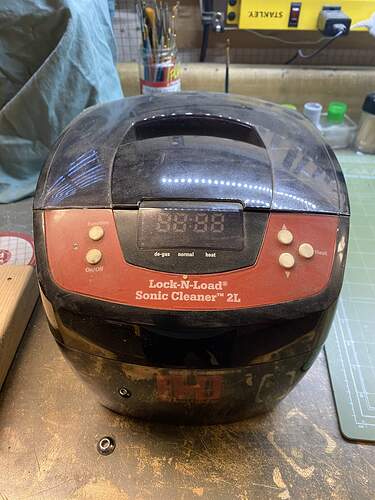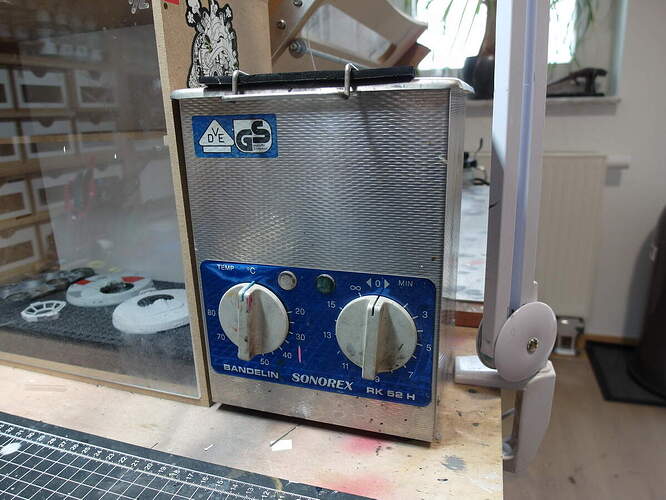what is the best airbrush cleaner for doing a deep clean?
That would depend on the paint that was used .
I am aware of the negative effects of ammonia on brass but I have been using Windex for years with no apparent ill effects.
I run a little Windex through after using acrylic water based paints followed by lacquer thinner. Last step is Vallejo airbrush cleaner for it’s supposed lubrication properties.
For deep clean I disassemble and soak parts in lacquer thinner then a dunking of all in the ultrasonic cleaner. Reassemble with super lube on needle and trigger.
For a really thorough cleaning, I disassemble the airbrush completely and dunk it in a heated sonic cleaner filled with tap water and a couple drops of dishwashing soap for an hour or so.
The results are pretty amazing. Removes acrylics and enamels and even paints that use a hardener additive like DuraCoat.
This one was originally intended to be used for cleaning gun parts. Because of this it has a plastic basket. Cleans carbon out of bolt carrier groups in minutes, too.
I use windex then I am done spraying for the day followed up IPA to clean out the windex.
Deep clean I have used windex in the ultrasonic cleaner, with not good results with the basket. Otherwise I used water.
i have only ever shot tamiya acrylic paint through it, i thought about soaking it in Mr Muscle oven degreaser for a little while.
I can only agree with Arch-Stanton.
The very best cleaning for an airbrush gun is an ultrasonic cleaner like this one…
The one I use here is an expensive professional device, but there are also cheaper ones.
Depends on what paints you’ve been using.
I’ve found both Tamiya airbrush cleaner and Mr Hobby cleaners effective for enamels, lacquers etc.
I occasionally use Vallejo primers for dioramas and found best to use their own cleaners. Tamiya and Mr Hobby strip it well enough, but cause it to clump and clog the airbrush in an almighty mess. I’d imagine the same would go for model air and other acrylics etc.
Others use cheaper alternatives as IPA or cellulose thinners.
Be careful using ultrasonic cleaners. They may cause surface pitting (cavitation) on aluminum parts.
My session-end cleaning with Tamiya acrylics is to shoot some screenwash through - it’s cheap and does a good job. For the occasional deep clean I take the parts outside and spray Badger AB cleaner through them - it’s xylene-based and eats EVERYTHING. Then I do a round of washing and rinsing before reassembly. In the bad old days folks used to soak the nozzles in cheap whisky overnight… (Save the good whisky for soaking tonsils, of course!)
So I’ve been using an ultrasonic cleaner for my pistols for years and don’t know of anything gentler to clean. Especially since airbrush guns are not made of soft aluminum.
It may all depend on the particular alloy. I use the Simple Green HD purple safe for aluminum gun parts. But even water in an ultrasonic can ruin some aluminum variations. I used an ultrasonic in my office to clean an anodized aluminum impression coping for dental implants. The coping lost most of its anodization and the remaining surface was rough.
You just have to know what you’re cleaning.
I only spray acrylics and I use Simple Green diluted a bit with purified water. Spot cleaning w Windex but pretty much Simple Green, I have one glass jar that I use to spray out my airbrush. I pretty much spray until what I get out is straight SG. I use it on a cotton swab to wipe needles, tips etc down also. It’s gentle and strong enough to get my brushes in good shape again.
I wish we could get hold of Simple Green here in the UK! I’ve seen it used to strip paint on model trains to great effect, but as far as I can tell it’s a US-only product…
Try this site for contact info
https://www.simplegreen.co.uk/index.php/simple-green-uk-about-us
I would be very cautious (i.e., Don’t) about using oven cleaner or Cellulose/lacquer to soak any airbrush with rubber seals like some Badgers, the rubber absorbs the lacquer & get damaged.
I would not use anything potentially flammable in an Ultrasonic cleaner, warm water with dish-soap is fine.
You could put smaller parts in a sealed pot with the thinner/cleaner of your choice & put that in your ultrasonic cleaner.
Thanks!
I was thinking more about using it as a paint stripper for “recycled” model trains - I agree about rubber seals being an issue.

